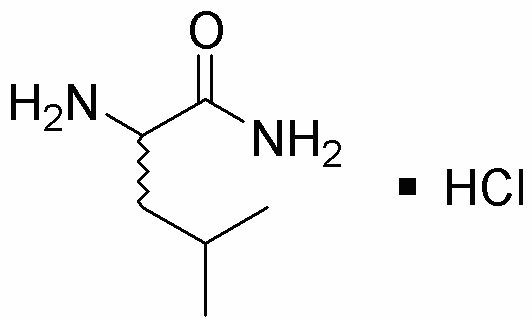DL-Leucine amide hydrochloride is widely utilized in research focused on:
- Pharmaceutical Development: This compound is used in the formulation of drugs aimed at enhancing muscle recovery and growth, making it valuable in sports medicine.
- Biotechnology: It serves as a building block in peptide synthesis, which is crucial for developing biologically active compounds in various therapeutic applications.
- Nutrition Supplements: Commonly found in dietary supplements, it supports muscle protein synthesis, appealing to fitness enthusiasts and athletes looking to improve performance.
- Research on Metabolic Disorders: It aids in studying metabolic pathways, particularly in conditions like diabetes, providing insights into amino acid metabolism and its effects on insulin sensitivity.
- Food Industry: Used as a flavor enhancer and nutritional additive, it improves the amino acid profile of food products, appealing to health-conscious consumers.
General Information
Properties
Safety and Regulations
Applications
DL-Leucine amide hydrochloride is widely utilized in research focused on:
- Pharmaceutical Development: This compound is used in the formulation of drugs aimed at enhancing muscle recovery and growth, making it valuable in sports medicine.
- Biotechnology: It serves as a building block in peptide synthesis, which is crucial for developing biologically active compounds in various therapeutic applications.
- Nutrition Supplements: Commonly found in dietary supplements, it supports muscle protein synthesis, appealing to fitness enthusiasts and athletes looking to improve performance.
- Research on Metabolic Disorders: It aids in studying metabolic pathways, particularly in conditions like diabetes, providing insights into amino acid metabolism and its effects on insulin sensitivity.
- Food Industry: Used as a flavor enhancer and nutritional additive, it improves the amino acid profile of food products, appealing to health-conscious consumers.
Documents
Safety Data Sheets (SDS)
The SDS provides comprehensive safety information on handling, storage, and disposal of the product.
Product Specification (PS)
The PS provides a comprehensive breakdown of the product’s properties, including chemical composition, physical state, purity, and storage requirements. It also details acceptable quality ranges and the product's intended applications.
Certificates of Analysis (COA)
Search for Certificates of Analysis (COA) by entering the products Lot Number. Lot and Batch Numbers can be found on a product’s label following the words ‘Lot’ or ‘Batch’.
*Catalog Number
*Lot Number
Certificates Of Origin (COO)
This COO confirms the country where the product was manufactured, and also details the materials and components used in it and whether it is derived from natural, synthetic, or other specific sources. This certificate may be required for customs, trade, and regulatory compliance.
*Catalog Number
*Lot Number
Safety Data Sheets (SDS)
The SDS provides comprehensive safety information on handling, storage, and disposal of the product.
DownloadProduct Specification (PS)
The PS provides a comprehensive breakdown of the product’s properties, including chemical composition, physical state, purity, and storage requirements. It also details acceptable quality ranges and the product's intended applications.
DownloadCertificates of Analysis (COA)
Search for Certificates of Analysis (COA) by entering the products Lot Number. Lot and Batch Numbers can be found on a product’s label following the words ‘Lot’ or ‘Batch’.
*Catalog Number
*Lot Number
Certificates Of Origin (COO)
This COO confirms the country where the product was manufactured, and also details the materials and components used in it and whether it is derived from natural, synthetic, or other specific sources. This certificate may be required for customs, trade, and regulatory compliance.


